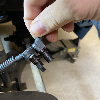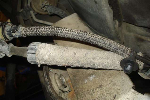I have a 2001 330i bmw and i had replaced all for rims when i had the installed the car was pulling to the right. I then went back to the tire shop and asked for a wheel alignment the tech asked me why i need a wheel alignment and i explained he then said to me that i had to get the hub centric rings i then called tire discount.com and they shipped me the rings and that was the end of the pulling and shimming. So i guess the hub centric rings are very important....., so what is the response to this..?
BMWs use lug bolts instead of 60* tapered lug nuts. For some reason, cars that use lug bolts can't hold the wheel steady as well as lug nuts. Plus, if your wheel didn't have a lot of contact area to the hub face, then there's less frictional area to resist that sliding movement. And if you didn't tighten the lugs with the wheel in the air, that will also contribute.
Think about it: when you stick a bolt (or a dowel pin) in a hole, the ones that go in easy, there is some slop in the fitment, the ones that don't go in easy need to be lined up perfectly and requires some force to get the pin in the hole. If this is a wheel, slop = dangerous vibrations. Now imagine Susie Homemaker is changing a tire on the side of the highway. She lifts the new tire into place and needs to not only line up the lug studs to the wheel holes but also needs to line up the hub bore and then push it (force it) onto the hub? I don't think so. I've changed LOTS of wheels (I use to autox and crew for road race teams) and have never had to force a wheel onto the hub.
Plus forcing an aluminum wheel onto a steel hub flange....... Aluminum is soft, steel is hard. The wheel hub bore would get "wallowed" out after awhile and not be round if this were the case. And then that non-round hub bore would be a nightmare to get centered up.
Instead here's what you should do: go jack up your Explorer and take the wheel off. Then put it back on- but just held in place with your hand. Notice how the lug studs are positioned in the wheel holes- you may need to push the wheel and hold it so it sits flat against the hub/brake rotor. You'll probably notice that the studs are "high" in the holes. If it was hub centric, they would be completely centered except for any clocking of the wheel. Now only put on the top most lug nut. As the tapered part of the lug nut engages the tapered part of the wheel, watch what happens to the position of the wheel. It moves the wheel up! Don't tighten it to final torque just yet. Check the position of the other lug studs in their holes. Put another lug nut on- choose the one as directly opposite the installed lug nut as possible. Again, watch the wheel as the taper engages. Install the rest of the lug nuts and tighten them by going opposite to opposite until you've done all of them. Now torque them by placing something under the tire (your foot, a 2x4, a brick, a rock......) to keep the wheel from turning. Lower the Explorer and you're done.
And again, notice how perfectly centered that hub is to the center bore in the wheel pictured in the original post- and all without even touching it.












